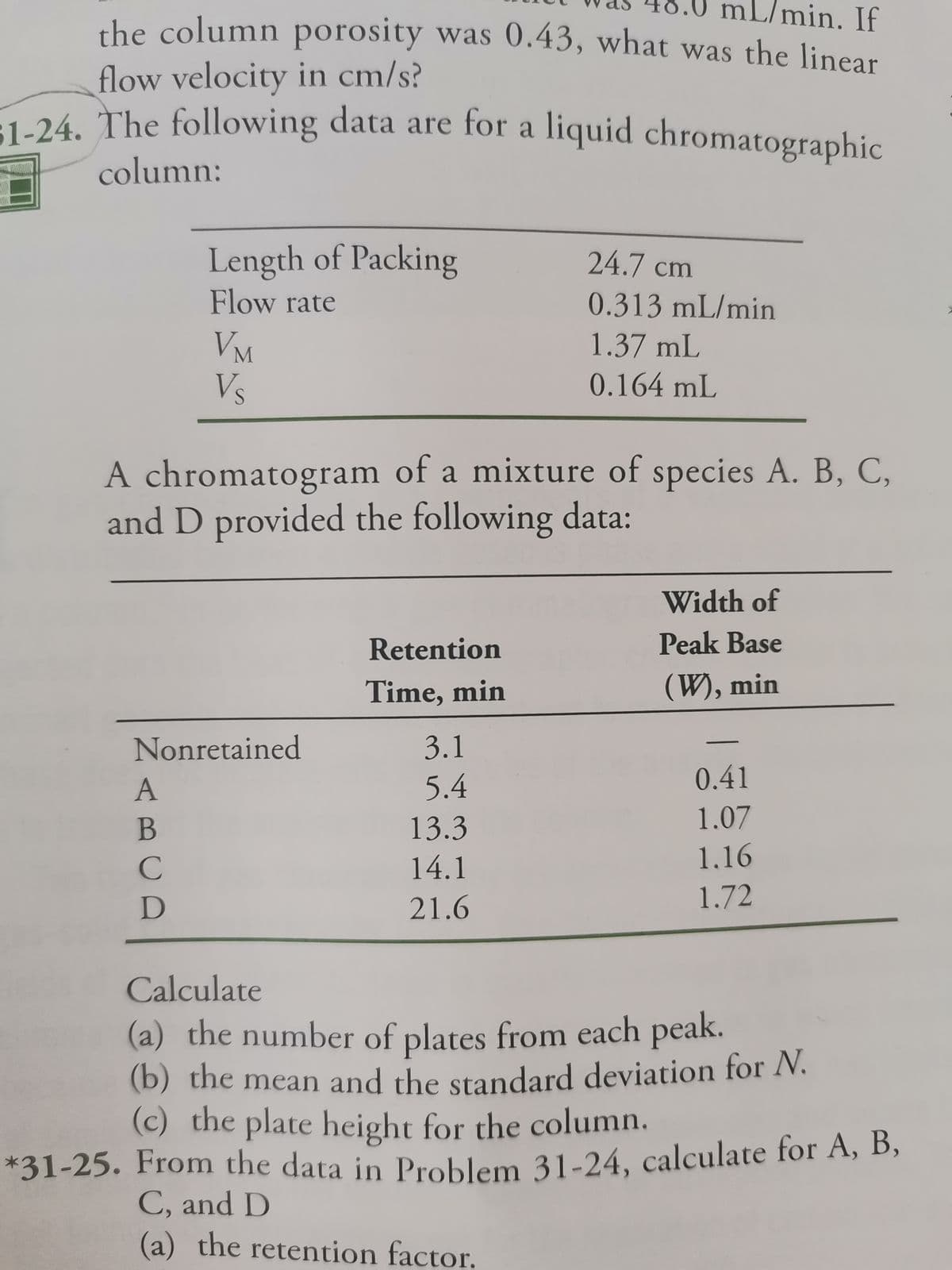-24. The following data are for a liquid chromatographic column: Length of Packing Flow rate VM Vs A B C D A chromatogram of a mixture of species A. B, C, and D provided the following data: Nonretained Retention Time, min 3.1 5.4 24.7 cm 0.313 mL/min 1.37 mL 0.164 mL 13.3 14.1 21.6 Width of Peak Base (W), min 0.41 1.07 1.16 1.72 Calculate (a) the number of plates from each peak. (b) the mean and the standard deviation for N. (c) the plate height for the column. A B
-24. The following data are for a liquid chromatographic column: Length of Packing Flow rate VM Vs A B C D A chromatogram of a mixture of species A. B, C, and D provided the following data: Nonretained Retention Time, min 3.1 5.4 24.7 cm 0.313 mL/min 1.37 mL 0.164 mL 13.3 14.1 21.6 Width of Peak Base (W), min 0.41 1.07 1.16 1.72 Calculate (a) the number of plates from each peak. (b) the mean and the standard deviation for N. (c) the plate height for the column. A B
Principles of Instrumental Analysis
7th Edition
ISBN:9781305577213
Author:Douglas A. Skoog, F. James Holler, Stanley R. Crouch
Publisher:Douglas A. Skoog, F. James Holler, Stanley R. Crouch
Chapter26: An Introduction To Chromatographic Separations
Section: Chapter Questions
Problem 26.14QAP
Related questions
Question
From the data calculate :
a) the number of plates from each peak
b) the mean and the standard deviation for N
c) the plate height for the column

Transcribed Image Text:L/min. If
the column porosity was 0.43, what was the linear
flow velocity in cm/s?
1-24. The following data are for a liquid chromatographic
column:
Length of Packing
Flow rate
VM
Vs
A
B
C
D
A chromatogram of a mixture of species A. B, C,
and D provided the following data:
Nonretained
Retention
Time, min
3.1
5.4
24.7 cm
0.313 mL/min
1.37 mL
0.164 mL
13.3
14.1
21.6
Width of
Peak Base
(W), min
0.41
1.07
1.16
1.72
Calculate
(a) the number of plates from each peak.
(b) the mean and the standard deviation for N.
(c) the plate height for the column.
*31-25. From the data in Problem 31-24, calculate for A, B,
C, and D
(a) the retention factor.
Expert Solution
This question has been solved!
Explore an expertly crafted, step-by-step solution for a thorough understanding of key concepts.
This is a popular solution!
Trending now
This is a popular solution!
Step by step
Solved in 4 steps

Knowledge Booster
Learn more about
Need a deep-dive on the concept behind this application? Look no further. Learn more about this topic, chemistry and related others by exploring similar questions and additional content below.Recommended textbooks for you

Principles of Instrumental Analysis
Chemistry
ISBN:
9781305577213
Author:
Douglas A. Skoog, F. James Holler, Stanley R. Crouch
Publisher:
Cengage Learning



Principles of Instrumental Analysis
Chemistry
ISBN:
9781305577213
Author:
Douglas A. Skoog, F. James Holler, Stanley R. Crouch
Publisher:
Cengage Learning

